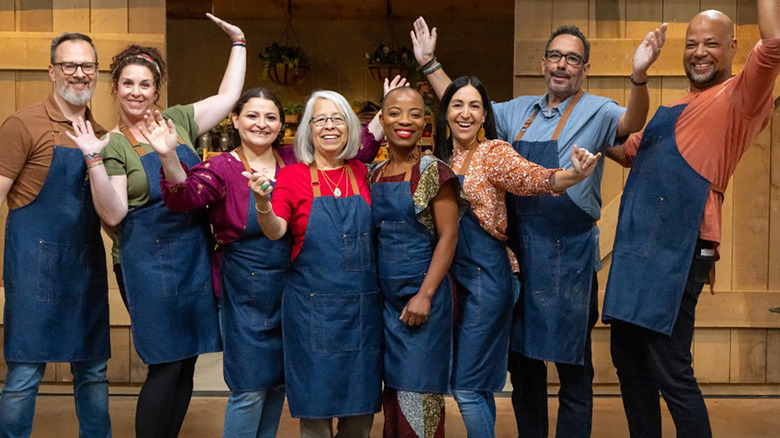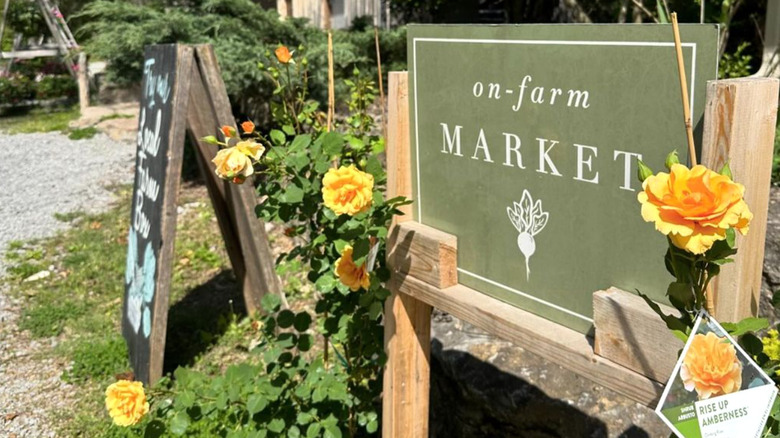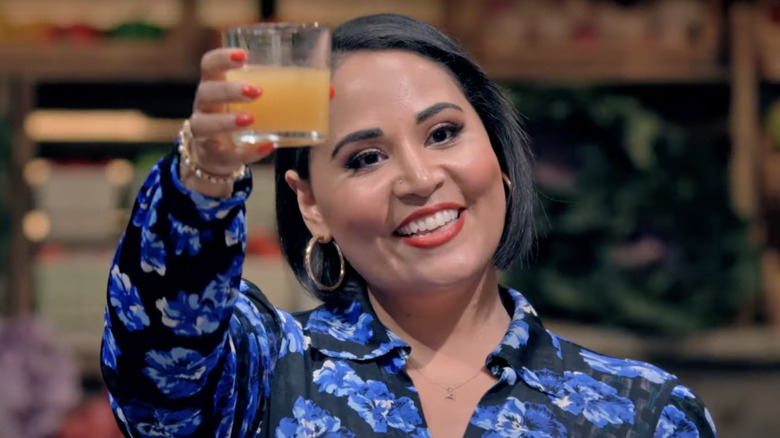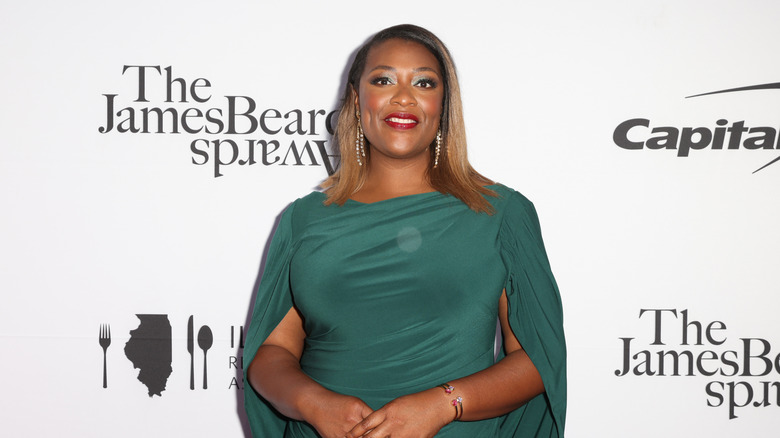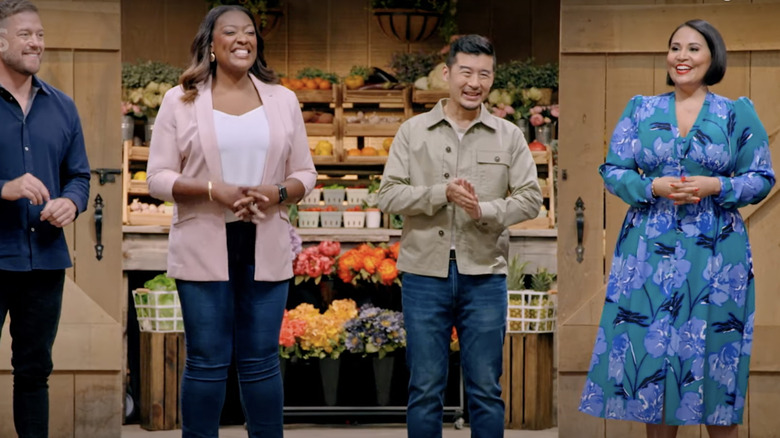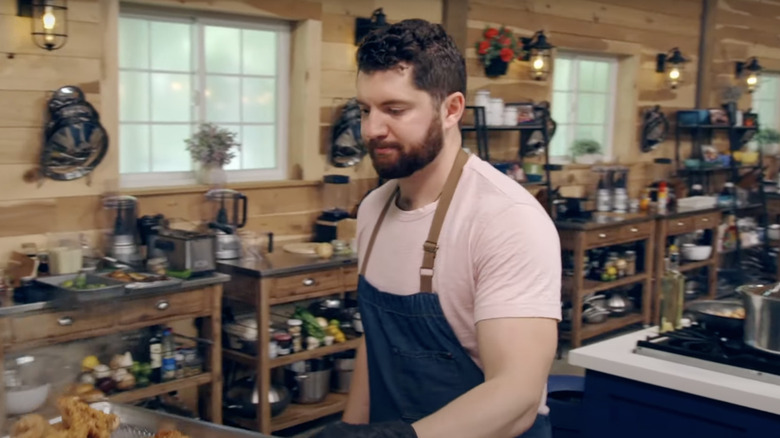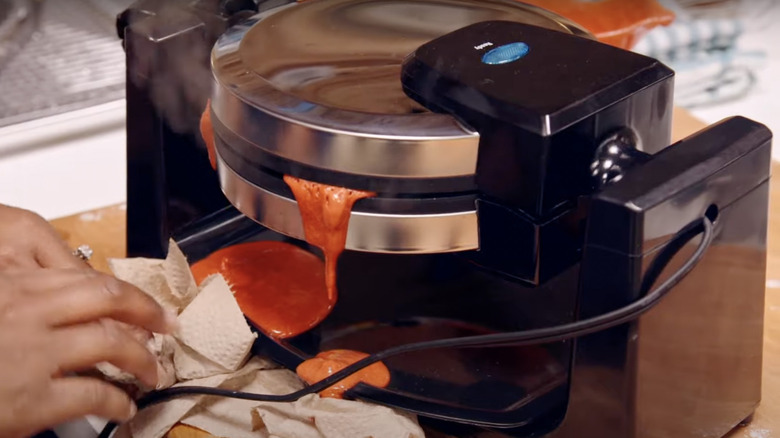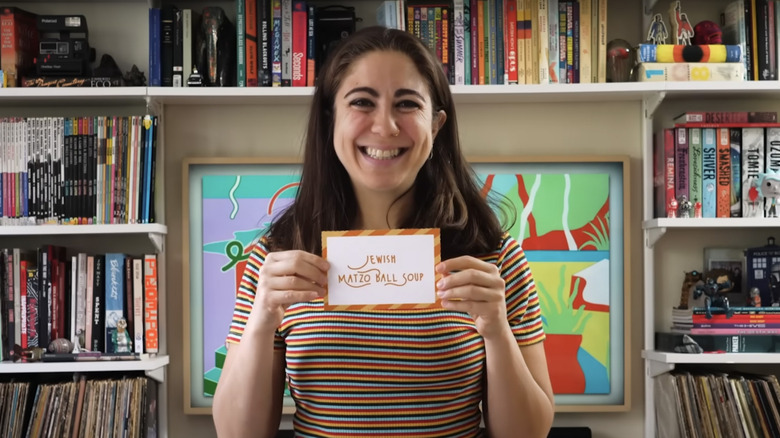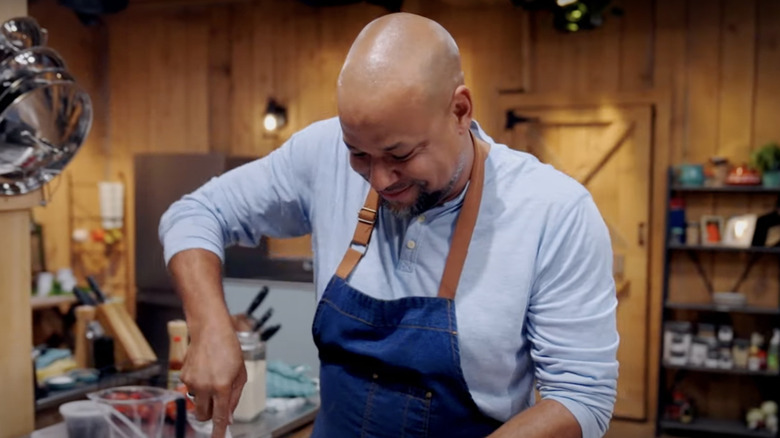Behind The Scenes Of The Great American Recipe
We may receive a commission on purchases made from links.
There is no shortage of cooking competition shows to watch in our streaming age. However, many of them are defined by tough competition among the competitors and tougher love from the judges (see any Gordon Ramsay property). But if you prefer your reality sides on the gentler side, check out "The Great American Recipe," from PBS.
Launched in 2022 to celebrate home cooks and a diversity of cooking styles and cultures, the show is defined by a spirit of community pride and encouragement. In the first seasons, the show was set in a barn, drawing comparisons to "The Great British Bake Off" in design and temperament. Additionally, there's no cash prize; just the opportunity to showcase regional cuisine, family traditions, and natural talent on national television. And instead of making the chefs grab from the same master pantry for their dishes, "The Great American Recipe" stocks each of the eight to 10 contestants' stations with individualized ingredients for their regional specialties.
In an interview with Richmond Magazine, Steve Humble, chief content officer at VPM in Virginia, says "The thought was ... how do we bring these recipes forward through these wonderful stories, which is what makes America so great, this passing down of recipes."
"The Great American Recipe" launched its third season in 2024 and is continue to prove that there is a demand for friendlier, more encouraging reality television. Read on for insights into what goes on behind the scenes of this warm and fuzzy competition show!
The show has a new filming location
If you've been watching "The Great American Recipe" since its very first season, then you may already be familiar with its primary shooting location of Ruther Glen, located in Caroline County, Virginia. Specifically, the show has filmed at the The Barns at Mattaponi Springs — more well known amongst locals as a wedding venue. This location was a blend of rural and refined that visually represented a slice of America. It was also expansive enough to host a fairly large community kitchen where the chefs could do their cooking.
Season 2 continued in Virginia up until the finale, at which point production moved to Woodlands, Texas at Dosey Doe — The Big Barn. This location is often used as a music venue that also serves food, making it the perfect location for a visually pleasing season finisher. It also is the first time a production has moved into the barn, making it extra unique.
However, in Season 3, the show began shaking things up and moved to Nashville, Tennesse at The Green Door Gourmet. This sweeping location is part of a 350-acre farm that also hosts a market and is a local source of agritourism. For a show that emphasizes the beauty of America's regional cooking styles, it makes sense to keep embracing new areas to in which to shoot the show. Time will tell if there's another move in the works for the next season!
There's plenty to learn about host Alejandra Ramos
While a few of the judges on "The Great American Recipe" have changed over the three seasons that it's been on air, one personality that has remained a consistent presence is host Alejandra Ramos.
Although she spent a stint in Italy after college, Ramos is based in and originally from New York, where she frequently appears in-studio on kitchen segments as a "TODAY" show contributor on NBC and Peacock. Her Puerto Rican heritage plays into many of her recipes and connects her culturally with contestants of diverse backgrounds on "The Great American Recipe." Prior to her hosting duties on PBS, Ramos also used to host "Food Network Kitchen" and was a co-host on Amazon Live's "Today's Deals Live."
But that's hardly all there is to her resume. In addition to her broadcast hosting and cooking background, Ramos has also carved out a space in the body positivity movement and as a champion for other BIPOC, Latinx, and female creators. To that end, she has acted as a brand ambassador and model for Maggy London. She also makes sure to highlight small business owners from diverse communities when she appears on television.
Judge Tiffany Derry is more than a chef
Alejandra Ramos isn't the only regular on "The Great American Recipe" who has a diverse background and a wide variety of interests. Texas native and judge Tiffany Derry grew up on a farm and is best known as a chef — she graduated with her culinary degree from Art Institute of Houston and appeared on "Top Chef" Season 7 and "Top Chef: All-Stars." But there's no reason to stop there. She's also a successful business woman.
In 2013, Derry founded Tiffany Derry Concepts, which supports her various ventures that include brand partnerships, work on television shows, and her (now shuttered) café, The Cupboard by Tiffany Derry. It also encompasses her currently operating restaurants, Roots Chicken Shak and Roots Southern Table, both of which are based in Texas. In 2016, she also co-founded T2D Concepts, which covers both her 'Shef Tiffany spice and apparel lines. That last, a venture known as DerryWear, is a line of statement t-shirts that the brand states are "curated to empower!"
Yet when she was a teenager, she was reportedly denied a cooking job at IHOP because of her race and gender, and has since stated that experience shaped her. Derry is passionate and outspoken about social justice, food access, and gender and race equity. She previously lobbied in Washington, D.C. and worked on getting the farm bill updated in 2013. She is also a spokesperson for the James Beard Foundation's sustainability efforts and works with Food Policy Action.
There are new Season 3 judges
In Seasons 1 and 2, audiences got used to seeing the rapport among judges and chefs Leah Cohen, Tiffany Derry and Graham Elliot. However, in Season 3, while Derry is returning, Cohen and Elliot have departed. In their place, new faces chef Tim Hollingsworth and food writer Francis Lam will appear.
Born in Houston, Hollingsworth is an award-winning chef currently based in Los Angeles, where he opened contemporary American restaurant Otium in 2015, fried chicken stand C.J. Boyd's in 2018, and Chain in 2022. Prior to running his own enterprises, Hollingsworth worked at the world-renowned French Laundry, where he spent four years in the demanding role of Chef de Cuisine, and traveled the world studying under such chefs as Gordon Ramsay. Hollingsorth won the 2010 James Beard Foundation's Rising Chef of the Year Award and has appeared as a contestant on Netflix's "The Final Table" (admittedly not liked by critics) and Food Network's "Tournament of Champions."
Although Lam also has cooking in his background (he graduated top of his class at the Culinary Institute of America), he is best known as host of podcast "The Splendid Table." Previously, Lam has also written columns for a variety of food publications, including Gourmet, Bon Appetít, Food & Wine, and more. He has also served as a judge on Bravo's "Top Chef Masters."
Host Alejandra Ramos said in a behind-the-scenes clip that Hollingsworth and Lam are "bringing their knowledge and warmth to our beautiful little family" — tune in to see how right she is!
There are no open auditions for contestants
There have been many stories of intense audition processes required of anyone who wants toappear on cooking competition shows. Part of the often untold truth of "Masterchef" is that it even includes the trials as part of the show as it airs.Yet, in line with "The Great American Recipe's" kinder, gentler approach to presenting the chefs and their dishes, there are no formal auditions required of contestants. Every chef that appears on the show has already been vetted and invited to join by the show's casting producers.
Season 2 winner Brad Mahlof shared in a group interview with THIRTEEN that his Instagram account featuring his Jewish cooking blew up during the pandemic. A producer contacted him through a direct message on the platform. Mahlof said he thought it was a scam and was hesitant to click on the casting link. It's a good thing he did! Similarly, Season 2 contestant Salmah Hack said in the same interview she was also contacted via Instagram DM. She also thought it was a scammer trying to fleece her until they also connected on LinkedIn.
Ingrid Portillo, a contestant on Season 3, explained to PBS how she shared her recipes on Instagram and TikTok. When a producer reached out, she was happy to follow the links and get more information.
Hack, Mahlof and Portillo all said they focused their accounts on personal connections to their food and were frequent posters. So if you want to be found, take their lead and get to posting!
The contestants have some serious camaraderie
Clearly, as The Great British Baking Show has demonstrated, lowering the temperature on the high pressure competition leads to more genuine feelings. It's been well-documented that there's a real affection amongst contestants. Plus, in any high stakes environment, it's natural for the participants to draw close together. One element that was introduced in Season 2 was a non-elimination format (at least until the finale). This allowed everyone to relax and get to know each other over a longer period of time. It also refocused the show on celebration instead of competition.
In an early interview, executive producer Layla Smith told Current that PBS was never going to be the channel where people would tune in for drama and fights. INstead, the show leaned into a more supportive format. "They wanted it to be celebratory. They wanted the chefs to cheer each other on," she explained.
Ted Pappas, a Season 2 competitor from Chicago, told WTTW the experience on the show was made better because of the camaraderie, and "We have our group text chat ... It's so fun to be able to have that new extended family."
Judge Tiffany Derry backs Pappas up, noting that the culture of this show is wildly different from others she's been a part of. "I've never done [a competition show] where everyone was kind and loving," she told East Bay Express. She also pointef out that she prefers to be the kind of judge who builds someone up rather than tear them down.
Production flubs and kitchen mistakes occasionally happen
Surely everyone loves a good, wholesome blooper! "The Great American Recipe" has plenty of mistakes and goofiness that don't make their way on screen. In the very first season, there were reports that the air conditioning stopped working on the first day of filming and, just as potentially disastrous, an oven stopped functioning as well.
As for the blooper side, contestants from Season 1 were constantly misspeaking or misremembering ingredients, while judges were cracking jokes and singing. Due to the partially outdoor location, apparently bugs were the offscreen stars as well, given how often there are outtakes of everyone swatting and avoiding the mostly unseen on camera terrors. The good news is that, on the whole, there were plenty of laughs and it appears that everyone was truly enjoying themselves — even when they had to go in for another take or two.
In Season 2, the cameras captured everything from a waffle iron overflowing with batter to a contestant using the floor as a prep station, to more than one chef either mismanaging their time or their ingredients. Luckily, the supportive judges were on hand to offer help and suggestions in an effort to smooth things over.
There is a digital companion show
If you just can't get enough of "The Great American Recipe," then you're in luck. In 2023 for Season 2, PBS debuted a digital companion show titled "Pan Pals" and hosted by Beryl Shereshewsky. Shereshewsky is based in New York and admits she's not a chef, but rather a producer and videographer who has a deep appreciation food. The concept of the show, similar to "The Great American Recipe," is cross-cultural exchange, where a variety of chefs and food influencers (some who have appeared on the show and some who haven't) exchange recipes like pen pals. They spend time going through their counterpart's instructions on how to prepare the meal, and exploring a dish and culture that frequently is unfamiliar to them.
Each episode highlights a dish, ingredient, or theme for the cooks to riff on, and the streaming show airs weekly on PBS Food's YouTube channel and PBS.com and the PBS app. One of the most recent episodes, a companion of Season 3, features an exchange of noodles. Shereshewsky notes that while noodles exist in every culture, what separates them are the type of noodles, the sauces, spices, and textures, and they feature two cooks who swap Cantonese noodles and a Burmese-Pakistani dish. Another Season 3 episode focused on dessert, with a Filipino and British exchange.
It's fascinating to watch as the home chefs learn about each other's culture through preparing these dishes, mirroring the experience of "The Great American Recipe" concept.
The contestants are not just judged on their recipes
While cooking is, of course, one of the most important elements of a competition show featuring chefs, what sets "The Great American Recipe" apart is how the contestants are actually judged. Cooking is only one component of the overall score.
In an interview with Reality Blurred, judge Tiffany Derry noted that Season 2 winner Brad Mahlof was chosen to come out on top because he "showed tremendous growth." She continued to explain that while of course the recipe itself matters, it's also about "what they tell us through the food and through words."
Judge Leah Cohen also added to this sentiment that she appreciated a great story, and the ability of a contestant to adapt to judge feedback. Judge Graham Elliot, in a separate interview with NBC affiliate KGET agreed, saying "you see these recipes that they present us beforehand and...you'll see them adapt as they go forward." Season 2 winner Brad Mahlof agreed that he thought the judges were actually encouraging them to take new tips and tricks and pivot their planned recipes as they went along.
Host Alejandra Ramos acknowledges that taste, presentation, and execution are traditionally part of the judging portfolio, but story really is the most important in this case. This includes why the dish is important or special. She hopes that storytelling will also resonate with the audience and help them remember special culinary moments in their own lives.
You can make their recipes at home
If you see a delicious dish on "The Great American Recipe" and want to recreate it at home, you're in luck — the recipes are posted online and in two editions of the show's cookbook! Both of Season 1 and 2's winning recipes are featured on the cover of each respective book.
"The Great American Recipe Cookbook" was released in August 2022 and features over 100 recipes not just from all 10 home chefs on Season 1, but all three judges and host Alejandra Ramos. Recipes include Southern Smoke Mac and Cheese, Back-to-School Fried Rice, Korean-Style Meatloaf and Potatoes, and Tres Leches Cake, just to name a few. The book has colorful pictures shot by Richmond-based Fred & Elliott Photography, and personal stories alongside the delicious dishes.
The Season 2 cookbook was published in August 2023 and contains an additional 100 recipes from the contestants, judges, and host. These include Bison Pho, Not My Mom's Noodle Kugel, BBQ Glazed Pork Ribs with KC Cheesy Corn, and Liliko'i (Passion Fruit) Bars. One customer review from J. Matthew Phipps said, "The recipes are good, explained well, and the tasty. The photography is beautiful. The organization of the book is wonderful."
If you just can't wait until August 2024 for the Season 3 book, those recipes are published in real time on the PBS website. Some of the current recipes available are a Strawberry Pretzel Dessert, El Paso Style Chiles Rellenos, Buddha's Feast, and Plantain Cookies.
